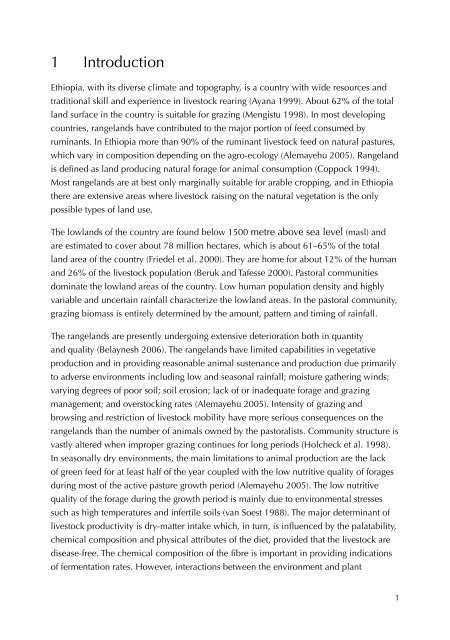Rangeland condition and feed resources in Metema District, North ...
Rangeland condition and feed resources in Metema District, North ...
Rangeland condition and feed resources in Metema District, North ...
You also want an ePaper? Increase the reach of your titles
YUMPU automatically turns print PDFs into web optimized ePapers that Google loves.
1 Introduction<br />
Ethiopia, with its diverse climate <strong>and</strong> topography, is a country with wide <strong>resources</strong> <strong>and</strong><br />
traditional skill <strong>and</strong> experience <strong>in</strong> livestock rear<strong>in</strong>g (Ayana 1999). About 62% of the total<br />
l<strong>and</strong> surface <strong>in</strong> the country is suitable for graz<strong>in</strong>g (Mengistu 1998). In most develop<strong>in</strong>g<br />
countries, rangel<strong>and</strong>s have contributed to the major portion of <strong>feed</strong> consumed by<br />
rum<strong>in</strong>ants. In Ethiopia more than 90% of the rum<strong>in</strong>ant livestock <strong>feed</strong> on natural pastures,<br />
which vary <strong>in</strong> composition depend<strong>in</strong>g on the agro-ecology (Alemayehu 2005). <strong>Rangel<strong>and</strong></strong><br />
is def<strong>in</strong>ed as l<strong>and</strong> produc<strong>in</strong>g natural forage for animal consumption (Coppock 1994).<br />
Most rangel<strong>and</strong>s are at best only marg<strong>in</strong>ally suitable for arable cropp<strong>in</strong>g, <strong>and</strong> <strong>in</strong> Ethiopia<br />
there are extensive areas where livestock rais<strong>in</strong>g on the natural vegetation is the only<br />
possible types of l<strong>and</strong> use.<br />
The lowl<strong>and</strong>s of the country are found below 1500 metre above sea level (masl) <strong>and</strong><br />
are estimated to cover about 78 million hectares, which is about 61–65% of the total<br />
l<strong>and</strong> area of the country (Friedel et al. 2000). They are home for about 12% of the human<br />
<strong>and</strong> 26% of the livestock population (Beruk <strong>and</strong> Tafesse 2000). Pastoral communities<br />
dom<strong>in</strong>ate the lowl<strong>and</strong> areas of the country. Low human population density <strong>and</strong> highly<br />
variable <strong>and</strong> uncerta<strong>in</strong> ra<strong>in</strong>fall characterize the lowl<strong>and</strong> areas. In the pastoral community,<br />
graz<strong>in</strong>g biomass is entirely determ<strong>in</strong>ed by the amount, pattern <strong>and</strong> tim<strong>in</strong>g of ra<strong>in</strong>fall.<br />
The rangel<strong>and</strong>s are presently undergo<strong>in</strong>g extensive deterioration both <strong>in</strong> quantity<br />
<strong>and</strong> quality (Belaynesh 2006). The rangel<strong>and</strong>s have limited capabilities <strong>in</strong> vegetative<br />
production <strong>and</strong> <strong>in</strong> provid<strong>in</strong>g reasonable animal sustenance <strong>and</strong> production due primarily<br />
to adverse environments <strong>in</strong>clud<strong>in</strong>g low <strong>and</strong> seasonal ra<strong>in</strong>fall; moisture gather<strong>in</strong>g w<strong>in</strong>ds;<br />
vary<strong>in</strong>g degrees of poor soil; soil erosion; lack of or <strong>in</strong>adequate forage <strong>and</strong> graz<strong>in</strong>g<br />
management; <strong>and</strong> overstock<strong>in</strong>g rates (Alemayehu 2005). Intensity of graz<strong>in</strong>g <strong>and</strong><br />
brows<strong>in</strong>g <strong>and</strong> restriction of livestock mobility have more serious consequences on the<br />
rangel<strong>and</strong>s than the number of animals owned by the pastoralists. Community structure is<br />
vastly altered when improper graz<strong>in</strong>g cont<strong>in</strong>ues for long periods (Holcheck et al. 1998).<br />
In seasonally dry environments, the ma<strong>in</strong> limitations to animal production are the lack<br />
of green <strong>feed</strong> for at least half of the year coupled with the low nutritive quality of forages<br />
dur<strong>in</strong>g most of the active pasture growth period (Alemayehu 2005). The low nutritive<br />
quality of the forage dur<strong>in</strong>g the growth period is ma<strong>in</strong>ly due to environmental stresses<br />
such as high temperatures <strong>and</strong> <strong>in</strong>fertile soils (van Soest 1988). The major determ<strong>in</strong>ant of<br />
livestock productivity is dry-matter <strong>in</strong>take which, <strong>in</strong> turn, is <strong>in</strong>fluenced by the palatability,<br />
chemical composition <strong>and</strong> physical attributes of the diet, provided that the livestock are<br />
disease-free. The chemical composition of the fibre is important <strong>in</strong> provid<strong>in</strong>g <strong>in</strong>dications<br />
of fermentation rates. However, <strong>in</strong>teractions between the environment <strong>and</strong> plant<br />
1

















